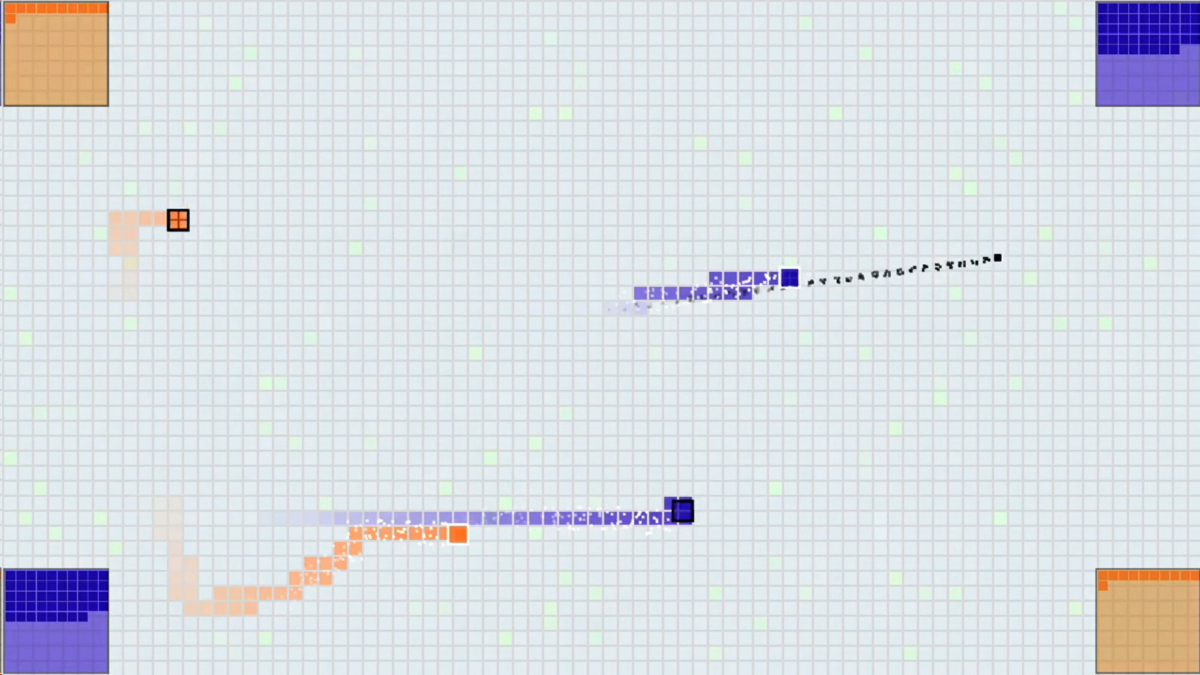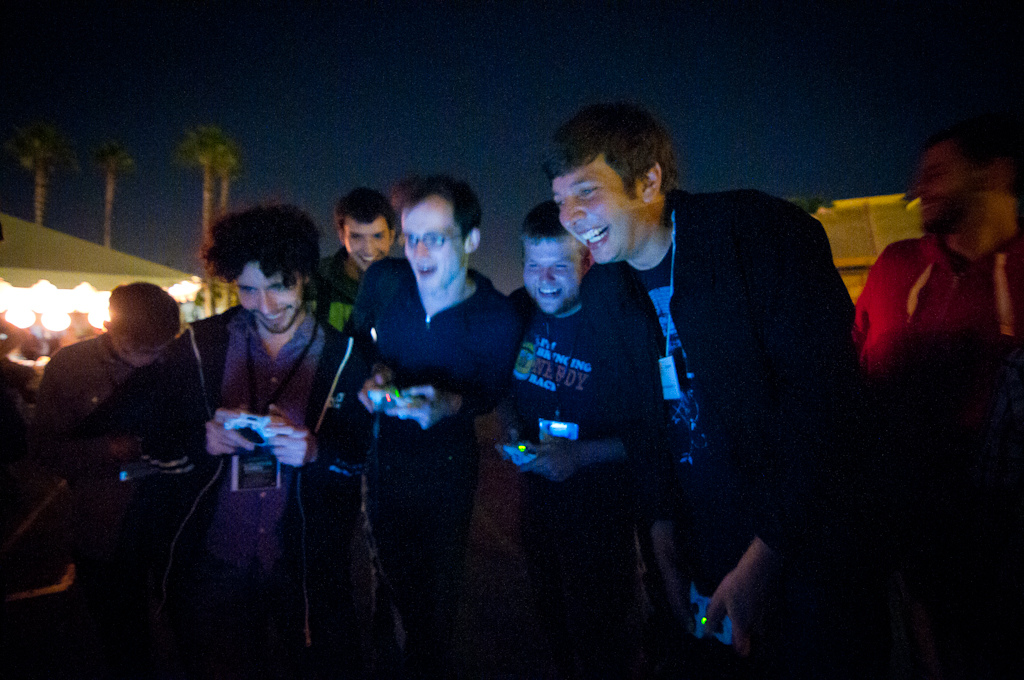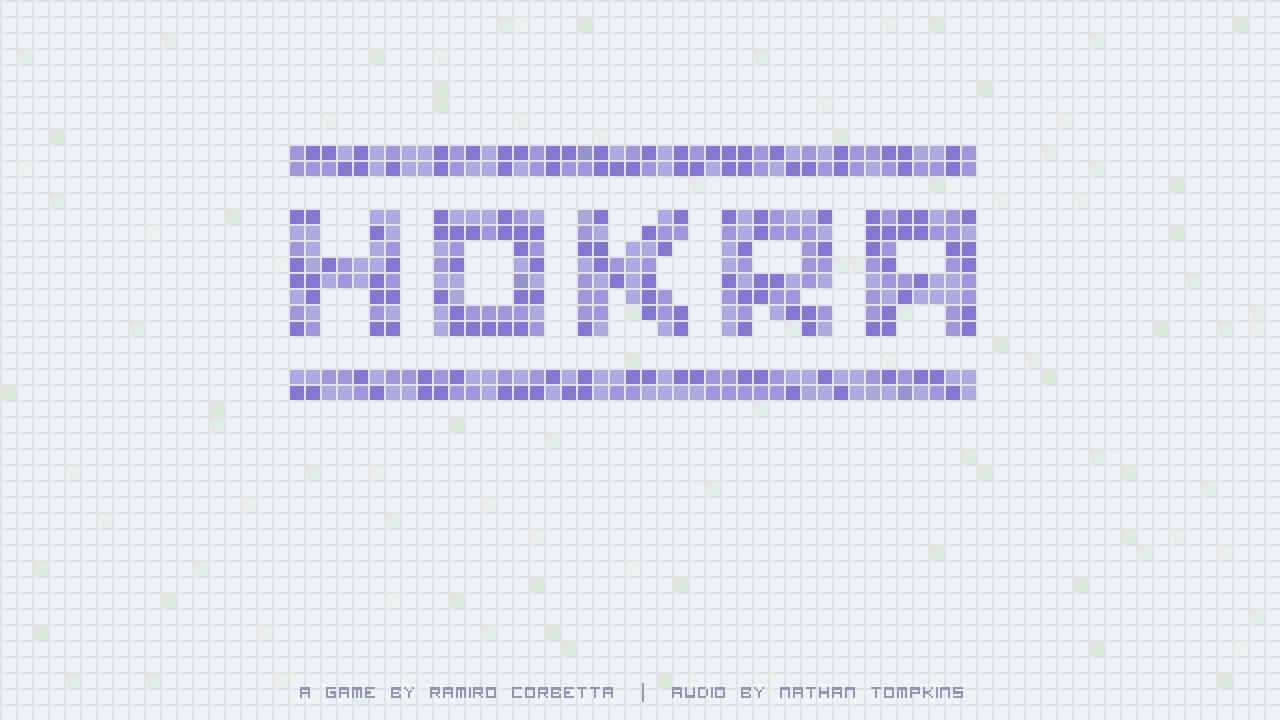indie interviews: ramiro corbetta on hokra
To my knowledge, it isn't yet common for games to be commissioned in the way that works of art were commissioned by patrons throughout history. Yet that's exactly how Hokra, by Ramiro Corbetta (with audio by Nathan Tompkins), came to be. Hokra is a 2v2 sports game where the teams are fighting over control of a single ball. When a player doesn't have the ball, she can sprint, and when she does, she can pass in any direction. Sprinting increases speed but removes the ability to change directions for a short while. Sprinting through an enemy player stuns him briefly and causes him to drop the ball. Scoring is achieved by maneuvering the ball into one of the team's colored zones in the corners, and counts whether or not the ball is currently in a player's possession. The first team to fill up the counter in their scoring zones wins.
I first played the game at IndieCade and instantly fell in love. A few simple mechanics (passing, zone control, sprinting, tackling) come together to make a deep and compelling multiplayer experience. The refined aesthetic calls to mind a top down view of a hockey rink and provides a simple backdrop for the competitive gameplay. If commissions to a single designer are going to result in games like this, I hope the practice continues to flourish.
Ramiro was gracious enough to take the time to answer some questions about the game below:
What inspired you to make Hokra?
When I began working on Hokra, I was just trying to program a simple passing mechanic. I had been playing lots of FIFA10 at the time (well, I still play it a lot), and to me passing is by far the most interesting mechanic in soccer games. So I put a square player on screen, then a smaller square ball. I was interested in getting the concept of passing in the direction you were pointing with an analog stick to feel just right, so I created simple 2D ball physics and a system where the longer you hold A, the stronger your pass will be. It was very straightforward, but that was the point. I wanted that feeling that when you made a good pass, you did it because you were very accurate. A friend of mine who is also into soccer was coming over one day, so I added a second square player and we tried moving around the “field” and passing the ball back and forth. The game (or, really, the toy) was already surprisingly compelling.
How did you settle on the victory condition of having the ball in your team's corners for a set period of time?
At this point, I decided that I should turn what I had into a proper game. Making it a two-on-two game was a no-brainer since I wanted a game about humans playing against each other and a one-on-one game wouldn't involve much passing. My first instinct was to make a game about scoring goals, or at least getting the ball to go through a goal, giving your team a point each time you did it. Before I even implemented that, I realized that in such a small field it would probably be more fulfilling to try to hold the ball over a “touchdown” zone than to just get it into a goal. I put the zones in opposite corners for symmetry. I assumed I'd come back later and change it because it wouldn't just work out. I really thought there would be a lot of iteration with the scoring conditions and the placement of the goals, but it turned out much better than I expected, so I stuck with it.
Why did you decide to make it a one button plus analog stick game?
 The next step was making it so that players would want to pass. As in real life sports, I wanted players to be slower when they had the ball. In order to do that, I allowed players who don't have the ball to sprint. At first, you'd press A to pass and X to sprint, but a friend asked me how come I was using two different buttons seeing as you can't pass when you don't have the ball and you can't sprint when you do have the ball. I told him I had thought about mapping both actions to the A button, but had never gotten around to it, which is a pretty bad excuse. I made the change on the spot (it was a one-character change in my code). Some friends still complain that sometimes you are sprinting toward the ball and you end up passing it by mistake (I've made tweaks to attempt to fix that problem). They ask me to go back to the two-button setup. I quite like the fact that you only press one button, though. The game was originally commissioned by the NYU Game Center for the 2011 No Quarter Exhibition, where lots of people would be playing the game for the first time, and they'd be doing it in a public space. Many of those people would not be gamers. I'm sure you've noticed that when people who don't play games that much are told to press the X button, they have to look down at the controller to figure out which one is the X button. I didn't want that problem to get in the way of people who were playing Hokra for the first time. Analog stick + A button makes the game more approachable. I'm always happy to make my games more approachable if I don't have to compromise on depth to do it.
The next step was making it so that players would want to pass. As in real life sports, I wanted players to be slower when they had the ball. In order to do that, I allowed players who don't have the ball to sprint. At first, you'd press A to pass and X to sprint, but a friend asked me how come I was using two different buttons seeing as you can't pass when you don't have the ball and you can't sprint when you do have the ball. I told him I had thought about mapping both actions to the A button, but had never gotten around to it, which is a pretty bad excuse. I made the change on the spot (it was a one-character change in my code). Some friends still complain that sometimes you are sprinting toward the ball and you end up passing it by mistake (I've made tweaks to attempt to fix that problem). They ask me to go back to the two-button setup. I quite like the fact that you only press one button, though. The game was originally commissioned by the NYU Game Center for the 2011 No Quarter Exhibition, where lots of people would be playing the game for the first time, and they'd be doing it in a public space. Many of those people would not be gamers. I'm sure you've noticed that when people who don't play games that much are told to press the X button, they have to look down at the controller to figure out which one is the X button. I didn't want that problem to get in the way of people who were playing Hokra for the first time. Analog stick + A button makes the game more approachable. I'm always happy to make my games more approachable if I don't have to compromise on depth to do it.
Where did the name come from?
When I was first working on the game, I was calling it “the sports game.” Obviously that wasn't going to stick. As the No Quarter Exhibition approached, Charles Pratt, who curates the event, told me that he needed a name from me. After going through a bunch of ideas, including SquareBall (which I liked, but was already taken), I started looking at names of Indigenous Brazilian sports. I'm originally from Brazil, and there are a few words in our Portuguese that come from Indigenous Brazilian languages. I ended up finding this sport from northern Brazil called rõkrã, which is similar to field hockey. This isn't a sport I knew about growing up, but it's similar to field hockey (a coconut is used as a ball and it's played barefoot, which sounds pretty scary) and I liked how the name sounded. I changed the R to and H because, with an American pronunciation, Hokra sounds more like the original name than Rokra.
What's your favorite memory of playing or watching others play Hokra?
 I have two really good memories. Toward the end of the night at the No Quarter Exhibition, a game that was being watched by maybe 15 people got extremely exciting. There was a lot of back-and-forth and the crowd was really getting into it, making loud “uuuuuhhhh” noises whenever somebody did something special. The game was really close, and when it ended the crowd broke into applause. At that point I felt like I had gotten the spectator aspect of sports right.
I have two really good memories. Toward the end of the night at the No Quarter Exhibition, a game that was being watched by maybe 15 people got extremely exciting. There was a lot of back-and-forth and the crowd was really getting into it, making loud “uuuuuhhhh” noises whenever somebody did something special. The game was really close, and when it ended the crowd broke into applause. At that point I felt like I had gotten the spectator aspect of sports right.
The second memory happened when the Hand Eye Society guys invited me to show the game in Toronto. It was July 4th and I was in Canada with two other NYC game developers who were also showing their games. At one point we ran the Canadian Hokra Tournament, and once we had a winning team a couple of us stepped up to challenge them for the North American tournament. The whole bar was watching the game, and when the Canadian team beat us, the entire place broke into “O Canada.” Some of my Canadian friends said that Hokra sparked a rare moment of Canadian patriotism.
What game designers inspire you the most and why?
Fumito Ueda was a big influence when I was starting out as a game designer. Playing Ico made me realize that I definitely wanted to create games for a living. It's interesting that now I make games that are really different, thematically, from his. But I think that his minimalist design aesthetic is still a huge influence over how I make games. I think that it's hard to find a game designer who isn't influenced by Miyamoto's work, but I still need to mention him here because of how brilliant some of his games are. Finally, these days, I'm probably most influenced by a game designer who happens to be a friend, too – Doug Wilson. His games, such as B.U.T.T.O.N. and Johann Sebastian Joust, are some of the most interesting multiplayer games I've played in a long time. His work is not only absolutely amazing, but it's also really inspiring, affecting how I make my games more than anybody else's work does.
You have won a prize. The prize has two options: the first is a year in Europe with a monthly stipend of $2,000, and the second is ten minutes on the moon. Which option do you select?
When I first read this question I thought it was ten SECONDS on the moon, so going to Europe seemed like an easy decision. Now that I know it's ten minutes it's much harder, but I think I'd still take the European trip. As amazing as the ten minutes on the moon would be, I think my life would change more by spending a year traveling around Europe while creating games. That is if $2000 per month is even enough to travel around Europe these days.
